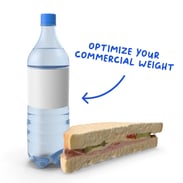How can airlines cut weight to boost flight efficiency
In the aviation world, where every ounce of weight translates to increased fuel burn and operational costs, weight reduction is a never-ending challenge. Commercial airlines increasingly focus on innovative ways to trim excess weight from their aircraft without compromising safety, passenger comfort, or essential functionality. This article delves into airlines’ strategies to reduce commercial weight and improve fuel efficiency.
The connection between weight and fuel efficiency
The first constraint when you fly is gravity. The heavier the aircraft, the more fuel is required to generate the necessary thrust for flight. The trick is that the more fuel you add, the heavier your aircraft gets hence the necessity of adding even more fuel. And it goes on and on. This is what we call the “Cost of Weight”. As such, every kilogram or pound saved contributes directly to reducing fuel consumption, operational costs, and carbon emissions.
Related Content >> How to use the cost of weight to be more fuel efficient?
One way to tackle aircraft weight reduction is to consider cutting down commercial weights, resulting in a noticeable drop in fuel consumption over the course of each flight.
What are commercial weights?
Commercial weights are all the items whose primary functions are commercial rather than safety-related. They concern several things, such as duty-free magazines, Inflight Entertainment Systems (IFEs), food and beverages, and even potable water. Airlines are the main actors who can act on these weights by changing cabin configuration or commercial load carried for each flight. Airlines have long known that making efforts on commercial weight allows greater fuel savings.
How can they be optimized?
 Some commercial weights can easily be reduced without compromising passengers’ comfort. Referring to statistics can dramatically help you direct your efforts in aircraft weight reduction and improve your fuel efficiency.
Some commercial weights can easily be reduced without compromising passengers’ comfort. Referring to statistics can dramatically help you direct your efforts in aircraft weight reduction and improve your fuel efficiency.
For instance, on potable water, many studies have revealed that some airlines put way too much potable water in their tanks¹, thus carrying much more weight than needed. Knowing how much potable water is used during flights can allow airlines to reduce their fuel consumption significantly by carrying less water.
In an aircraft, potable water is mainly used in the lavatory, but also for passengers’ drinks (water, coffee, tea) and even for showers in some first classes. Knowing how much potable water is actually used during flights can allow airlines to reduce their fuel consumption significantly by carrying less water and less useless weight.
Related Content >> Fly more efficiently with better potable water management.
As a Flight Operations Engineer, you could also measure how commercial loads such as duty-free, food and beverages are consumed. Suppose you notice that you systematically have leftover stock of apple juice after landing on specific flights and routes; this insight could lead you to optimize your commercial weight.
Aircraft weight reduction can also be achieved by putting an end to some commercial practices. Many airlines have recently given up on selling duty-free items, which helps to reduce fuel consumption.
Yet another option for cutting commercial weight is through digitalization. For example, switching in-flight reading magazines (one or two per passenger in most airlines) from paper to digital format can significantly help an airline reduce weight. Let’s take a closer look.
¹Planning Drinking Water on Planes, Marco Bijvank, Menno Dobber, Maarten Soomer, Vrije Universiteit Amsterdam Quentin Botton, Eleonore de le Court, Jean-Christophe Van den Schrieck, Moïra de Viron-Myriam Cisneros-Molina, Klaus Schmit- Remco van der Hofstad, Ellen Jochemsz, Tim Mussche, Martin Summer, Jeroen Mulder, Mark Paelinck
How much fuel could be saved in a year thanks to digitalizing an In-Flight Magazine?
In this example, let’s try to have a simplified calculation of savings made by digitalizing an in-flight reading magazine.
Every magazine copy weighs around 150g, it doesn’t seem like a lot, right?
Now picture an airplane with 300 passenger seats; that means 300 magazines or 45 kg of pure commercial weight. In order to reduce this commercial weight, you can, for instance, decide to remove the paper version of the magazine and store it online or display it in the in-flight entertainment (IFE) system. By doing this, you would reduce the carried weight by 45kg (or 99 lbs).
On an 8-hour flight, the saving would be 12.6 kg of fuel (or 27.8 lbs.) (a typical cost of weight is 3.5% per hour of flight).
If you operate a fleet of 25 long-haul airplanes that typically operate two flights per day, that’s about 230 tons (or 76,000 gallons) of fuel saved in a year just by removing the paper version of a magazine!
Of course, the amount of fuel saved depends on many factors such as the fleet, the routes flown, and aircraft weight reduction. But this calculation gives you a general idea of how fuel can be saved by adapting commercial weights and how important it is to take every detail into account when developing a fuel efficiency program.
Every. Gram. Matters.
 The bottom line is, small efforts pay off. Even simple actions like the ones outlined in this blog post can significantly drop fuel consumption over a year of operations.
The bottom line is, small efforts pay off. Even simple actions like the ones outlined in this blog post can significantly drop fuel consumption over a year of operations.
You’ve probably heard it before, it’s the little things that make a big difference. And it is particularly true when it comes to fuel efficiency where improvements can be made in all shapes and forms. Even something as insignificant as a 150g magazine could lead to great savings in the long run. They are what make a comprehensive and effective fuel efficiency program.
LEARN MORE
Do you want to improve your fuel efficiency?
Read a detailed case study about best practices from airlines that are saving big:





